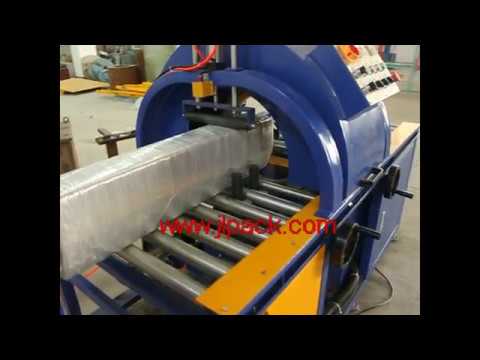Title: Ultimate Guide to Automatic and Semi-Automatic Orbital Wrapping Machines
Description:
Welcome to our comprehensive guide on Automatic Orbital Stretch Wrapper, Semi-automatic Orbital wrapping machine, and their versatile applications in wrapping various products such as mouldings, aluminium profiles, tubs, blinds, shelves, kit furniture, and more. In this video, we delve into the detailed features, benefits, and operation steps of these efficient wrapping machines.
Introduction:
In this informative video, we present an in-depth overview of Automatic Orbital Stretch Wrapper and Semi-automatic Orbital wrapping machine, highlighting their capabilities in securely wrapping a wide range of products. Whether you are a business owner, warehouse manager, or simply interested in packaging technologies, this video will provide valuable insights.
Video Content:
1. Key Features:
- High-quality construction and durable materials ensure long-lasting performance.
- User-friendly interface and intuitive controls for easy operation.
- Adjustable settings allow customization according to product dimensions and wrapping requirements.
- Efficient and consistent wrapping process for increased productivity.
- Versatile compatibility with various products, including mouldings, aluminium profiles, tubs, blinds, shelves, kit furniture, and more.
2. Benefits:
- Enhanced protection: These wrapping machines provide a secure and tight wrap, protecting products from damage during transportation or storage.
- Time-saving: Automating the wrapping process significantly reduces manual labor, saving valuable time and resources.
- Cost-effective: Improved efficiency and reduced material wastage contribute to cost savings in packaging operations.
- Versatility: With the ability to wrap different types of products, these machines offer flexibility in various industries.
3. Operation Steps:
- Step 1: Set the machine parameters, such as wrapping speed, tension, and rotation.
- Step 2: Place the product on the turntable or the conveyor belt, ensuring it is positioned correctly.
- Step 3: Activate the machine using the control panel or foot pedal.
- Step 4: As the machine rotates, it applies stretch film evenly around the product, creating a secure wrap.
- Step 5: Once the wrapping process is complete, remove the wrapped product and prepare for the next one.
Call to Action:
If you found this video helpful, please consider liking, subscribing, and sharing it with others who might benefit from this valuable information. Stay updated with our latest videos on packaging solutions for various industries. For any further inquiries or to explore our range of wrapping machines, feel free to reach out to us.
Additional Tags and Keywords:
Automatic Orbital Stretch Wrapper, Semi-automatic Orbital wrapping machine, mouldings, aluminium profiles, tubs, blinds, shelves, kit furniture, packaging solutions, wrapping technology, product protection, efficiency, cost savings, versatile wrapping.
Hashtags:
#AutomaticOrbitalStretchWrapper #SemiAutomaticOrbitalWrappingMachine #ProductPackaging #WrappingSolutions #EfficientPackaging #VersatileWrapping
Here's an example of a tilter program for a Semi-automatic Orbital Wrapping Machine:
```python
# Import necessary libraries
import RPi.GPIO as GPIO
import time
# Set the GPIO pin numbers
TILTER_PIN = 18
# Set the GPIO mode
GPIO.setmode(GPIO.BCM)
# Setup the GPIO pin for the tilter
GPIO.setup(TILTER_PIN, GPIO.OUT)
# Function to tilt the wrapping machine
def tilt_machine(angle):
# Convert angle to duty cycle for the servo motor
duty_cycle = ((angle / 180.0) * 10.0) + 2.5
# Generate PWM signal with the calculated duty cycle
pwm = GPIO.PWM(TILTER_PIN, 50) # 50 Hz frequency
pwm.start(duty_cycle)
# Wait for the servo to reach the desired angle
time.sleep(1)
# Stop the PWM signal
pwm.stop()
# Main program
if __name__ == "__main__":
try:
# Prompt user for the desired angle
angle = float(input("Enter the angle (in degrees) to tilt the machine: "))
# Tilt the machine to the desired angle
tilt_machine(angle)
except KeyboardInterrupt:
# Clean up GPIO on keyboard interrupt
GPIO.cleanup()
```
This tilter program uses the RPi.GPIO library to control the GPIO pins of the Raspberry Pi. It sets up a single GPIO pin (pin 18) to control the tilter mechanism of the wrapping machine. The `tilt_machine()` function takes an angle as input, converts it to a duty cycle for the servo motor, and generates a PWM signal to tilt the machine to the desired angle. The main program prompts the user for the desired angle and calls the `tilt_machine()` function accordingly. It also handles a keyboard interrupt (Ctrl+C) to clean up the GPIO pins before exiting the program.Orbital Stretch Wrapper
#Semiautomatic #Orbital #wrapping #machine
